Journey into Ladakh-Reflections!
 Ladakh gave me a silence that I had being waiting/longing for in awhile. It is far from the 24 hrs connectivity we are used to these days , there was no acccess to telephone, internet, tv, newspaper, since we are camping in the wilderness most of the days except the occasional pit stops at Leh. I was away from the happenings around the world/media for 15days and didn't miss it a bit !!
Ladakh gave me a silence that I had being waiting/longing for in awhile. It is far from the 24 hrs connectivity we are used to these days , there was no acccess to telephone, internet, tv, newspaper, since we are camping in the wilderness most of the days except the occasional pit stops at Leh. I was away from the happenings around the world/media for 15days and didn't miss it a bit !!As you travel through ladakh the long long journey and the silence and the huge empty spaces between towering mountains and the sky above, expands your own mind and you are part of that environment and your mind turns silent and becomes part of the landscape.
Its an high altitude desert surrounded by mountains.The entire region is frozen for 8 months in a year, where the temperature could go as low as -40 C. Its the extremest of climates and rain is rare. It has 4 months of scorching summer sun during the day and freezing evenings.
Everything in Ladakh reflects its relegious heritage. The landscape is dotted with Manis(walls with prayer stones) ,Stupas and flying Chortens(Prayer Flags) usually at a height up above in the monastery. Majority of Ladakhi's are buddhist and have been for centuries. Buddishim was initially introduced by Indians , however the current population mainly follows tibetan mahayana budhism .
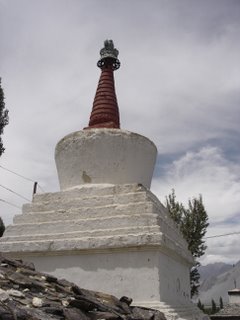 A Stupa is a building of plaster and brick that has four stages.A large cubic foundation, rising diminishing cubes that support a wide,empty, bun-like middle portion, which supports in its turn a long spire that comes to a point in the symbol of crescent moon cradling a sun.Its a building where relics are kept, the relics of saints or kings or very holy teachers, and each stage of the building symbolises a different state of consciousness. You will find stupas of various sizes all across Ladakh, on the slopes up to a Gompa, along the banks of rivers, entrance to villages.
A Stupa is a building of plaster and brick that has four stages.A large cubic foundation, rising diminishing cubes that support a wide,empty, bun-like middle portion, which supports in its turn a long spire that comes to a point in the symbol of crescent moon cradling a sun.Its a building where relics are kept, the relics of saints or kings or very holy teachers, and each stage of the building symbolises a different state of consciousness. You will find stupas of various sizes all across Ladakh, on the slopes up to a Gompa, along the banks of rivers, entrance to villages.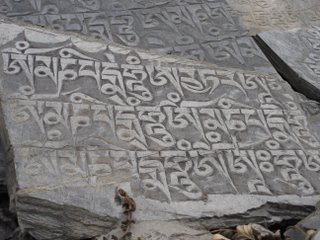 Mani is a wall with a long flat top where prayer stones are left,open to the wind and rain and snow. There are many all over Ladakh, outside Monasteries, villages, along the road, in fields, wastelands.. These Manis have centuries of prayers-large,small chipped stones haphazardly thrown, as if they had been deposited by a strong wind .
Mani is a wall with a long flat top where prayer stones are left,open to the wind and rain and snow. There are many all over Ladakh, outside Monasteries, villages, along the road, in fields, wastelands.. These Manis have centuries of prayers-large,small chipped stones haphazardly thrown, as if they had been deposited by a strong wind .Ladakhis pray naturally, on the sides of the roads,in buses, selling fruits, standing .. They need no special pomp. You will see a school kid on the way to school, just turning the prayer wheel or an old lady on the way to collect the dry hay stopping by next to the wheel.
You will see prayer stones across walls everywhere.It is only the shape of the wall that gives the stones some order ...As long as the stones are there and the wall is standing, the prayers and blessings will be carried from field to field across the mountains.
As you dwelve into the magnificient surroundings and the silent empty spaces around, you have enough time to reflect. The place somehow makes one philosphical and makes you wonder about your place and purpose on this very planet. I have travelled a bit but nothing prepared me for the immense impact the place has on its occupants, even for a temporary wanderer like me .
One feels the Empitness here ! . While reading some books on Ladakh, I came across a few Buddhist beliefs :Sunyata or "Emptiness" is the central element of Buddhism. It is said that the universe is like an endless river. Its totality, the unity does not change, yet at the same time it is in constant motion. The river as a whole exists, but you cannot say what it consists of; you cannot stop the flow and examine it. Everything is in movement and inextricably interwined.
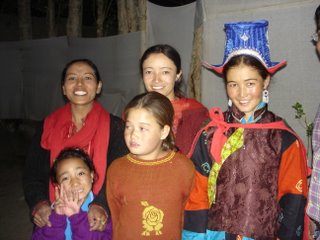 Juley,...The ladakhi's seem to be unusually happy , they have their share of problems and living in the harshest parts of the world but somehow.. they seem to have no fear unlike the industrialised world..they don't seem to be bogged down by deadlines, insecurities runing the industrialised world . Every street you cross, the harshest terrian you pass through, every man/woman/child will scream out juley and wave back at you.
Juley,...The ladakhi's seem to be unusually happy , they have their share of problems and living in the harshest parts of the world but somehow.. they seem to have no fear unlike the industrialised world..they don't seem to be bogged down by deadlines, insecurities runing the industrialised world . Every street you cross, the harshest terrian you pass through, every man/woman/child will scream out juley and wave back at you.I was reminded of our mad rush in the industrialised city life (Its worse these days with working in a global environment), of meeting deadlines, trying to earn loads of money but somehow forgetting to have that smile and peace in our daily lives that these folks displayed. Majoirty of the Ladakhi's are self sufficent farmers and have used ancient techniques to survive the harshest of conditions.
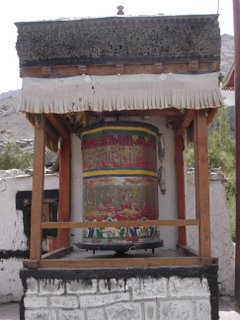 Religion is omnipresent and inseperable from all aspects of daily life.The ladakhis conception of reality is circular, one of a constant returning. There is not the sense that this life is the only opportunity. Death is as much a beginning as an end, a passing from one birth to next, not a final dissolution.
Religion is omnipresent and inseperable from all aspects of daily life.The ladakhis conception of reality is circular, one of a constant returning. There is not the sense that this life is the only opportunity. Death is as much a beginning as an end, a passing from one birth to next, not a final dissolution.I meet some interesting folks during this trip.
 Taashi and Murab(drivers), seen here enjoying a smoke at 5 a.m. in near subzero temp. Taashi, is a Msc (Anthropology) couldn't find a govt. job and hence became a driver.
Taashi and Murab(drivers), seen here enjoying a smoke at 5 a.m. in near subzero temp. Taashi, is a Msc (Anthropology) couldn't find a govt. job and hence became a driver.Murab, the one with the pointy hair has been driving in this terrain for 17 years, he is one of the happiest and most helpful person you can come across. The furthest he has travelled from Ladakh is Chandigarh.
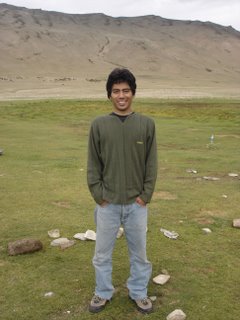
Peema, another localite, he speaks a couple of langauges (including Kannada, Tamil) , was sent to the Valley school by the Monastery . Has a immense knowledge of the local traditions and customs and issues around. A really nice chap!
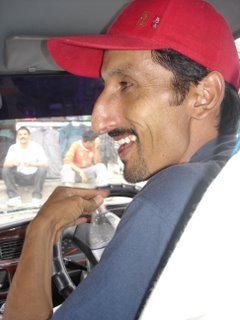 Bhagat Ram, from Manali. He has won the National Champ. in Para Gliding a couple of times. He skies as well!! He is the person who took us paragliding in Manali. He also toils in his wonderful apple orchard. A really nice and simple pahadi .
Bhagat Ram, from Manali. He has won the National Champ. in Para Gliding a couple of times. He skies as well!! He is the person who took us paragliding in Manali. He also toils in his wonderful apple orchard. A really nice and simple pahadi .Some Interesting Links:
Thangkas: The Wheel of Life


Comments